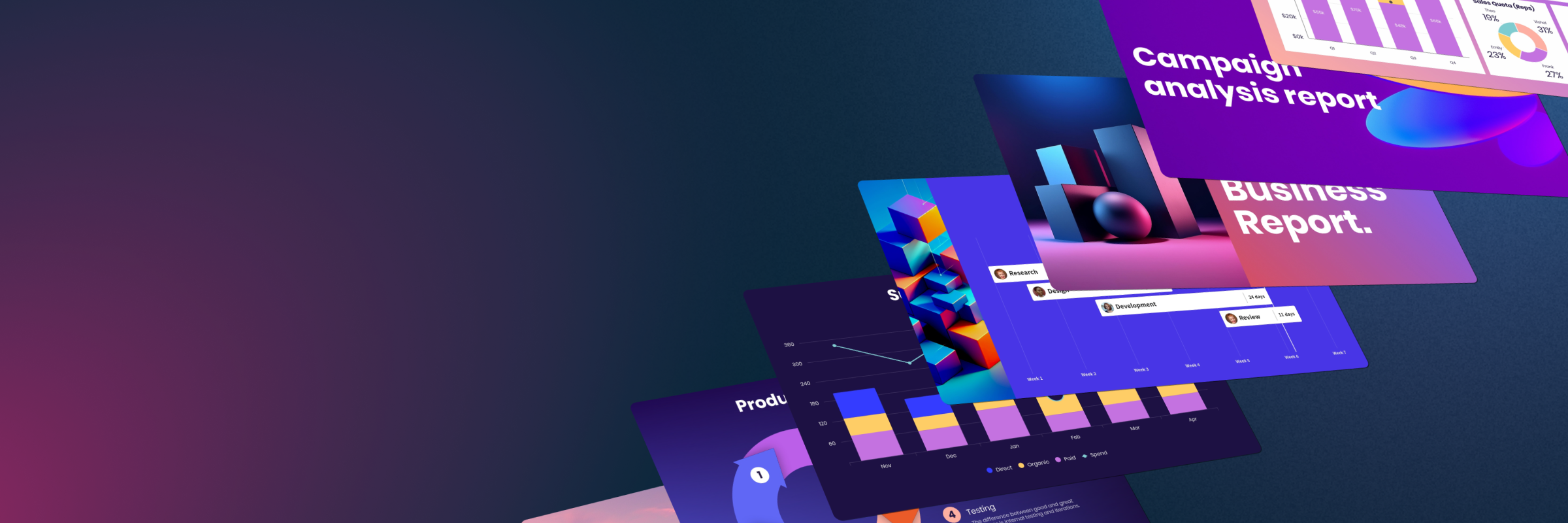
It’s 10 p.m. the night before a quarterly business review. Across time zones, teams are frantically copy-pasting numbers from dashboards into slides, double-checking that charts are up to date, and emailing “final_final_v3.pptx” to their managers. By the time the meeting starts the next morning, the data is already stale—and everyone knows it.
This scenario is painfully familiar. Static slides, once the backbone of business communication, simply can’t keep up with today’s pace of decision-making. In a world where teams rely on live metrics and real-time insights, manually updating decks simply doesn’t cut it.
Static slides are outdated, disconnected from the source of truth, and prone to errors. And as businesses demand agility and alignment, it’s time to leave them behind.
Why static slides are a bottleneck
The problem with static slides isn’t just the inconvenience. It’s the way they slow down and even derail business-critical work.
- Repetitive busywork: Copy-pasting charts and screenshots is a time suck. Teams waste hours transferring data instead of analyzing it.
- Version control chaos: When every stakeholder has their own version of a deck, no one knows which file is the source of truth.
- Data misalignment: A slide might show last week’s numbers while the dashboard already reflects today’s. Decisions get made on outdated or incomplete information.
This bottleneck compounds across functions—sales, operations, finance, marketing—dragging entire organizations back when they need to move forward.
The shift to dynamic, real-time presentations
The modern workplace demands agility. Teams need tools that move as fast as their priorities do. That shift is transforming the traditional presentation into something more efficient.
Dynamic presentations are no longer an innovative nice-to-have; they’re the new standard. When decks pull directly from real-time data, they don’t just show information—they become extensions of the systems teams already rely on. Instead of being static documents, presentations evolve continuously with the business.
What real-time data looks like in Beautiful.ai
Tools like Beautiful.ai are designed to eliminate the pain of static slides and empower teams with dynamic, data-driven storytelling.
- Auto-updating charts: Connect slides to uploaded or linked data sources so that charts refresh automatically as the underlying numbers change.
- Smart Slides and templates: Customizable templates help you rethink the structure of your slide so that your data can tell a clear, compelling story.
- Unbreakable design: With Smart Slide templates, formatting never falls apart, even as charts update or data scales.
- AI summarization: The AI assistant can take raw data and help you summarize key points and actionable takeaways to better refine your story.
The result is a deck that’s always accurate, always on-brand, and always ready to present—without the midnight scramble.
The benefits of better data visualization
The shift to better data visualization isn’t just about saving a few clicks. It changes the way teams operate (for the better).
1. Accuracy & trust
When your data is connected, there’s no risk of outdated charts undermining your credibility in a high-stakes meeting. Stakeholders can trust what they see, and leaders can make decisions with confidence.
2. Speed & scalability
Imagine updating one dashboard instead of 15 separate slide decks. Real-time presentations cut hours of manual updates, freeing teams to focus on strategy and execution.
3. Consistency
Branded templates ensure every deck looks professional and cohesive. No more off-brand fonts or misaligned charts. As data changes, the design adapts accordingly.
4. Collaboration
Connected decks become a shared resource across teams. Whether it’s sales, marketing, or finance, everyone stays aligned because they’re working from the same deck, with the same data, every time.
The bottom line (pun intended) is that data is important for any growing business. It tells a big story. Data helps inform better decisions, identify opportunities, and ultimately unlocks a more efficient business model. But data moves fast, so presentations need to move faster. Beautiful.ai helps professionals collaborate on important metrics and scale data-driven presentations, all while maintaining brand integrity and accuracy.
.gif)
.gif)





